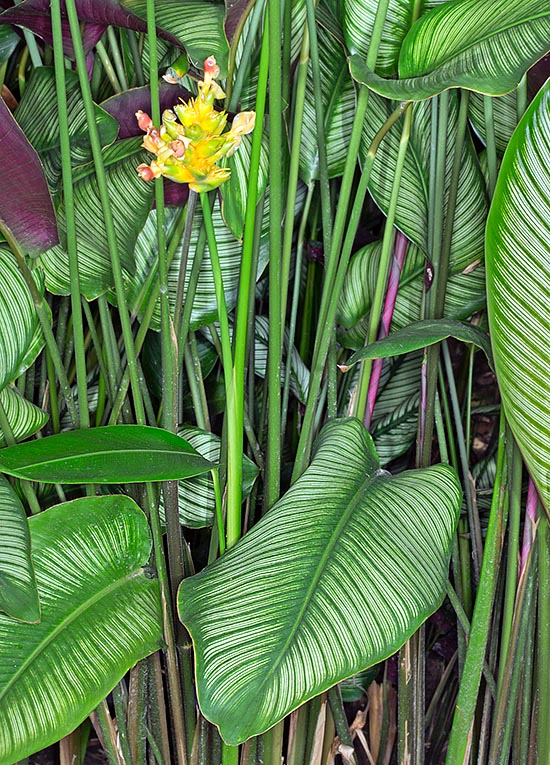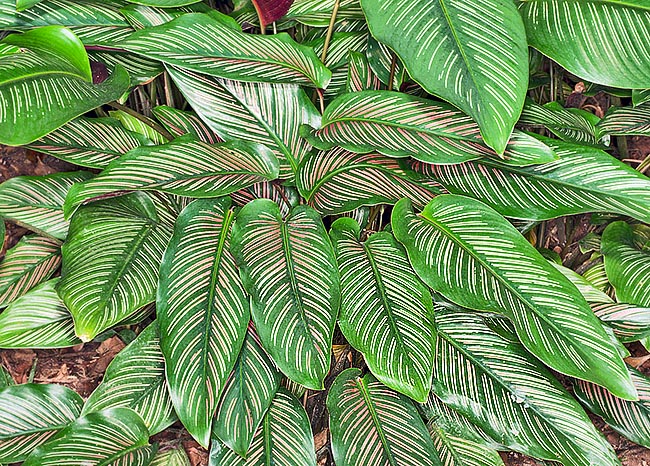Family : Marantaceae

Text © Pietro Puccio

English translation by Mario Beltramini

Goeppertia majestica forms 2,5 m tall tufts with 10 cm inflorescence © Giuseppe Mazza
The species is native to Brazil (Amazonas, Amapá, Pará, Roraima, Rondônia e Tocantins), Colombia, Ecuador, Guyana and Peru, where it grows in the pluvial forest up to about 500 m of altitude.
The genus is honoured to the German botanist and paleontologist Johann Heinrich Robert Goeppert (1800-1884); the name of the species is the Latin adjective “majesticus, a, um” = majestic.
Common names: majestic calathea (English); maranta-riscada, jacundá (Portuguese – Brazil).
The Goeppertia majestica (Linden) Borchs. & S.Suárez (2012) is an evergreen, rhizomatous perennial herbaceous species, forming thick tufts up to about 2,5 m tall, even if in cultivation it keeps lower. The leaves on a slightly tomentose cylindrical petiole, up to more than 1,5 m long, are simple, lanceolate to oblong-lanceolate with apex abruptly pointed, the young ones, up to bout 40 cm long and about 15 cm broad, are green on the upper page with white or pink white stripes arranged parallel to the lateral nervations, the ripe ones, up to about 80 cm long and about 25 cm broad, tend to become uniformly green, the lower page is always of purple violet colour.
The inflorescence, on a long peduncle, in form of compact spike about 10 cm long and of 7 cm of diameter, is formed by imbricate bracts spirally arranged, of yellowish green colour, enclosing up to 8 pairs of tubular, pubescent flowers with orange yellow corolla opening in succession. The fruits are capsules usually containing three seeds. It reproduces by seed, but usually and easily by division of rhizomes by late spring-early summer.
The name of the species is very appropriate for this species which has unusual dimensions for the genus and the particularly ornamental leaves, utilizable for edges, in mass or as ground cover in the humid tropical and subtropical climate zones in shaded or partially shaded position, but far away from the direct rays of the sun which may damage the foliage. It requires soils rich of organic substance, well drained, aerated, kept constantly humid, constant high temperatures, 24-28 °C, high humidity, 70-80%, and protection from the winds.
Frequently cultivated in pot for interiors decoration, it needs the same cares as many other species belonging to the genus. The loam must be organic with addition of siliceous sand or perlite per a 30%, for improving the drainage, and fragments of charcoal, the constant temperature, never less than 16 °C, and the position far from air currents.

The variety ‘Roseolineata’ is very decorative but the red stripes turn white with the time © Giuseppe Mazza
Remarkably important for the health of the plant is the ambient humidity which must be constant and high, condition not easy to obtain in an apartment, for increasing it the pot may be placed on a tray with gravel or other inert, kept constantly humid, and to do frequent nebulisations with non-calcareous water in order to avoid unaesthetic spots on the leaves. The watering must be regular, thus to maintain the substratum permanently humid, but without stagnations, which may cause fatal rottenness, utilizing preferably rain water, by reverse osmosis or demineralised at ambient temperature. The fertilizations, duly distributed and alternated, in way to avoid salts accumulation at the roots, are done during the vegetative period with hydro-soluble balanced products, with microelements, at ¼ of the dosage suggested on the package.
A frequent variety in cultivation is the ‘Roseolineata’ whose young leaves have pink stripes which, with the time, tend to be come white.
Synonyms: Maranta majestica Linden (1865); Maranta princeps Linden (1869); Calathea ornata var. majestica (Linden) E.Morren (1870); Calathea ornata var. majestica (Linden) Regel (1879); Calathea princeps (Linden) Regel (1879); Phyllodes princeps (Linden) Kuntze (1891); Maranta imperialis Burgerstein & Abel (1901); Calathea gigas Gagnep. (1903); Calathea imperialis (Burgerstein & Abel) L.H.Bailey (1914); Calathea majestica (Linden) H.A.Kenn. (1986).
